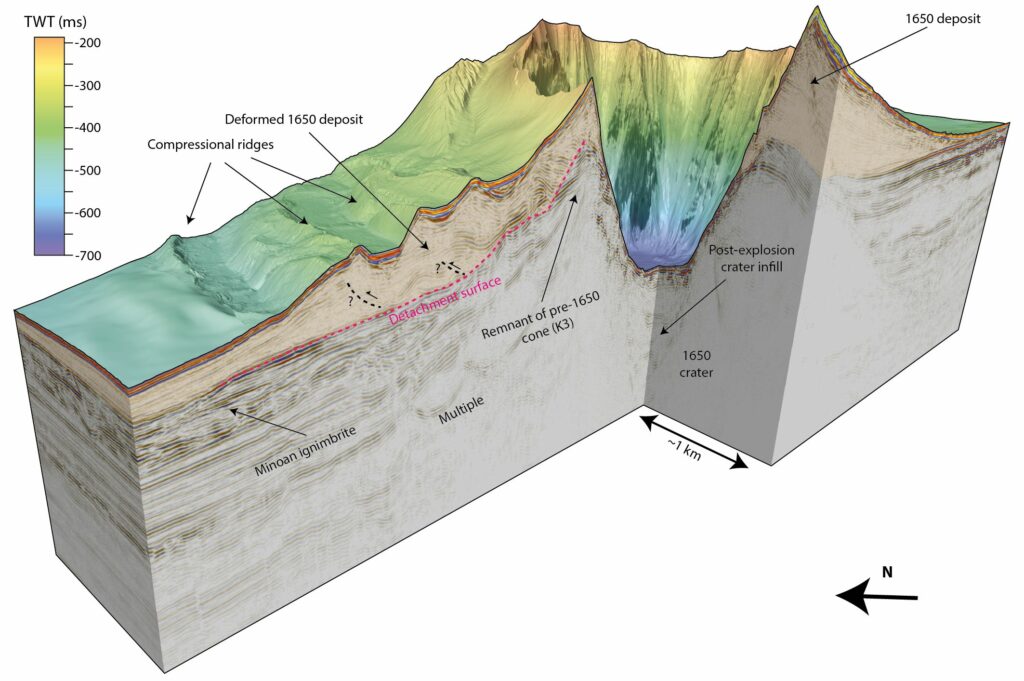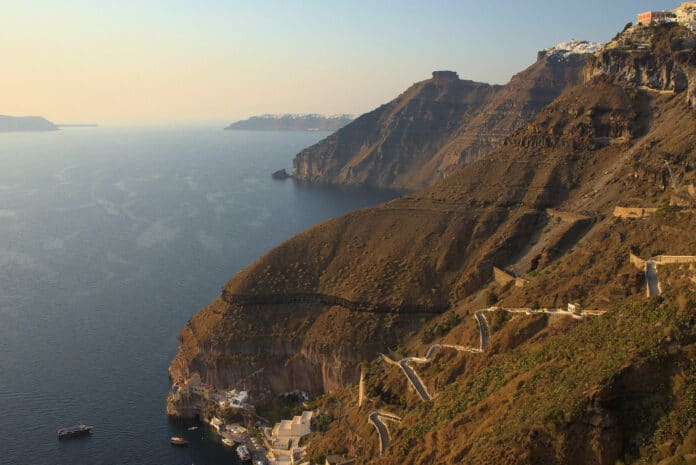Volcanic eruptions bring on tsunamis and potentially harm infrastructure and coastal communities seriously. During volcanic eruptions, a variety of factors combine to produce complicated tsunamis. The Kolumbo undersea volcano erupted in 1650, and the ensuing tsunami severely damaged nearby Aegean Sea islands. However, because it is challenging to sample and image underwater volcanoes, the primary mechanisms behind the tsunami have been called into question.
Utilizing cutting-edge imaging technology, a team of researchers headed by Dr. Jens Karstens from the GEOMAR Helmholtz Centre for Ocean Research Kiel has now studied Kolumbo’s underwater volcano and recreated the historical events. They discovered that the natural disaster, as reported by the witnesses, can only be explained by a landslide and an explosive eruption.
The eruption on the Greek island of Santorini has been apparent for a few weeks. People noticed the water’s color had changed and was boiling in the late summer of 1650. Gleaming rocks were being ejected by an underwater volcano that had emerged from the sea approximately seven kilometers northeast of Santorini. The sky was clouded by plumes of smoke, and flames and lightning were visible.
The water abruptly receded, only to erupt again a few moments later, pounding the coast with waves as high as twenty meters. More than 100 kilometers away, there was a loud explosion that caused pumice and ash to fall on the nearby islands and killed multiple people with a deadly cloud of poisonous gas.

Dr Jens Karstens, marine geophysicist at GEOMAR Helmholtz Centre for Ocean Research Kiel, said, “We know these details of the historical eruption of Kolumbo because there are contemporary reports that were compiled and published by a French volcanologist in the 19th century. We wanted to understand how the tsunami came about at that time and why the volcano exploded so violently.”
Using 3D seismic techniques, the scientists on board the now decommissioned research vessel POSEIDON produced a three-dimensional image of the crater, which is currently located eighteen meters below the surface of the ocean. Scientists were now able to examine the volcano’s inside.
The crater was 500 meters deep and 2.5 kilometers in diameter, according to 3D imaging, indicating a massive explosion. The seismic profiles also showed that one of the cone’s flanks had been significantly damaged.
Dr Gareth Crutchley, co-author of the study, said, “This part of the volcano has certainly slipped.” The researchers then took a detective’s approach, comparing the various mechanisms that could have caused the tsunami with the historical eyewitness accounts. They concluded that only a combination of a landslide followed by a volcanic explosion could explain the tsunami.”
Scientists then combined 3D seismics with computer simulations to reconstruct how high the waves would have been if they had been generated by the explosion alone.
This meant that six-meter waves would have been predicted at one specific spot, but eyewitness reports indicate that the waves were twenty meters high there. In addition, although the computer modeling shows that the sea receded initially at another site, a wave crest reaches the coast first. Thus, the tsunami phenomenon cannot be explained by the explosion alone. Nevertheless, the results matched historical observations when the landslide was incorporated into the simulations.
Karstens said, “Kolumbo consists partly of pumice with very steep slopes. It is not very stable. During the eruption, which had been going on for several weeks, lava was continuously ejected. Underneath the magma chamber, which contained a lot of gas, was enormous pressure. When one of the volcano’s flanks slipped, the effect was like uncorking a bottle of champagne: the sudden release of pressure allowed the gas in the magma system to expand, resulting in a huge explosion.”
“Something similar could have happened during the 2022 eruption of the Hunga Tonga undersea volcano, whose volcanic crater has a similar shape to Kolumbo’s.”
Thus, the study offers important data for creating active underwater volcanic activity monitoring programs for operational submarine volcanic activity, such as SANTORY.
Karstens said, “We hope to be able to use our results to develop new approaches to monitor volcanic unrest. Maybe even an early warning system, collecting data in real-time. That would be my dream.”
Journal Reference:
- Karstens J, Crutchley GJ, Hansteen TH, et al. (2023): Cascading events during the 1650 tsunamigenic eruption of Kolumbo volcano. Nature Communications. DOI: 10.1038/s41467-023-42261-y
